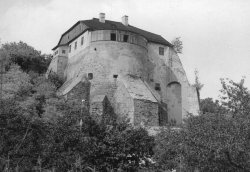OSTROH

The Chronicle of Bygone Years mentions Ostroh for the first time in 1100 in connection with one of the many princely battles of that time. However back then Ostroh was not a big town. Only after Mongol-Tatar invasion demolished virtually all Ukraine's cultural and political centers in the 13th century, the town of Ostroh in the marshes of Volyn got a chance for prominence. The first solid fortifications around the town were built in 1341 and local princes began to successfully resist Tatar attacks and increase their influence over the people.
But the real fame to the town was earned by two princes, Kostiantyn and Vasyl, who ruled in the XVI and early XVII centuries. Kostiantyn managed to establish rather large state within a state. He also defeated Ivan the Terrible forces during the Livonian War and earned the title of Grand Hetman of Lithuania. His territory extended from Bila Tserkva in the East and Turovo-Pinsk in the North. By the end of his life, Kostiantyn became one of the most powerful and authoritative princes of the Polish Commonwealth.
He made an exceptional contribution to the beauty of his capital. In the mid-sixteenth century, Ostroh became one of the largest towns in Ukraine with a population of over 20,000. Trade arteries went through the city, connecting Eastern and Western Europe. People then called sixteenth century Ostroh the Athens of Volyn. In addition to a powerful prince, large army, traders, and craftsmen, many scholars lived and worked in Ostroh. For instance, the cofounder of the most influential stream in current Judaism Marshua lived and taught there.
Kostiantyn's son, Vasyl added much to the town's fame. In the late sixteenth century he actually headed the Ukrainian resistance to the Catholic Counterreformation. With his huge wealth and army, Vasyl managed to prevent the major part of priests and gentry from converting to Catholicism and adhering to the Union of Brest. He went even further, establishing the first Eastern European institution of higher education, the Ostroh Academy. In the time of sharp ideological contradictions, when Ukraine could have been torn apart by civil war, the academy served as an arbiter, where medieval Polish and Ukrainian humanists could solve their problems and prevent the armed conflict. The central Polish authorities, supported by the Catholics, were hardly fond of the position of the Ostroh magnate, but could do little to interfere, And the Ostroh prince continued his work of enlightenment.
Before other of his contemporaries appreciated the power of propaganda, he invited Ivan Fiodorov to Ostroh to organize a print shop, and in his few years at the Ostroh Academy Fiodorov published six books, half of his lifetime output. While Prince Vasyl was Orthodox, he was able to tolerate any religion. Catholic cathedrals, synagogues, and mosques stood side by side Orthodox churches. Andriy Rymsha, a well-known theologist from Western Europe worked there. It seemed that this small town in the middle of war-torn Europe was living through an era of Enlightenment.
Soon the Ostroh Academy graduates established the Kiev-Mohyla Academy and fraternal schools in other Ukrainian towns and cities. Ostroh traders became wealthier, the warlike gentry launched trade operations, and even Tatar raids ceased. A Tatar district a with a mosque was built in the Ostroh suburbs.
However, the peaceful interlude did not last long. Shortly after Vasyl died, the conflict between Catholics and the Orthodox grew sharper in Ukraine. With help of the Jesuits, Vasyl’s children converted to the Uniate Church and later to Roman Catholicism. The Ostroh Academy was closed and replaced by a Jesuit Academy. The hatred between Ukrainians and Poles grew deeper. In Ostroh in 1648 Bohdan Khmelnytsky wrote a letter to the Polish king asking him to decrease pressure on the Orthodox Cossacks. The Polish authorities paid little attention to the elderly colonel. A year passed, and Khmelnytsky's rebel army took Ostroh. Shortly before, the last princess of Ostroh, Anna-Aloisa tortured the Orthodox dwellers of Ostroh. Khmelnytsky's Cossacks took revenge. The Jesuit school with its unique library and Ukraine's first observatory was devastated. Almost all Greek and Jewish retailers were killed. The war violated all principles of humanity.
The further history of Ostroh is much like the history of other Ukrainian towns. And the castle and cathedrals look strange in the sleepy and quiet town, which was once the cultural center for a major part of Eastern Europe.
Photo: Oleksiy Stasenko, The Day:
This grand castle reminds us of a city once the cultural center of Eastern Europe.
A former district seat defends its sixteenth century round bathtub.
Newspaper output №:
№5, (1998)Section
Culture





